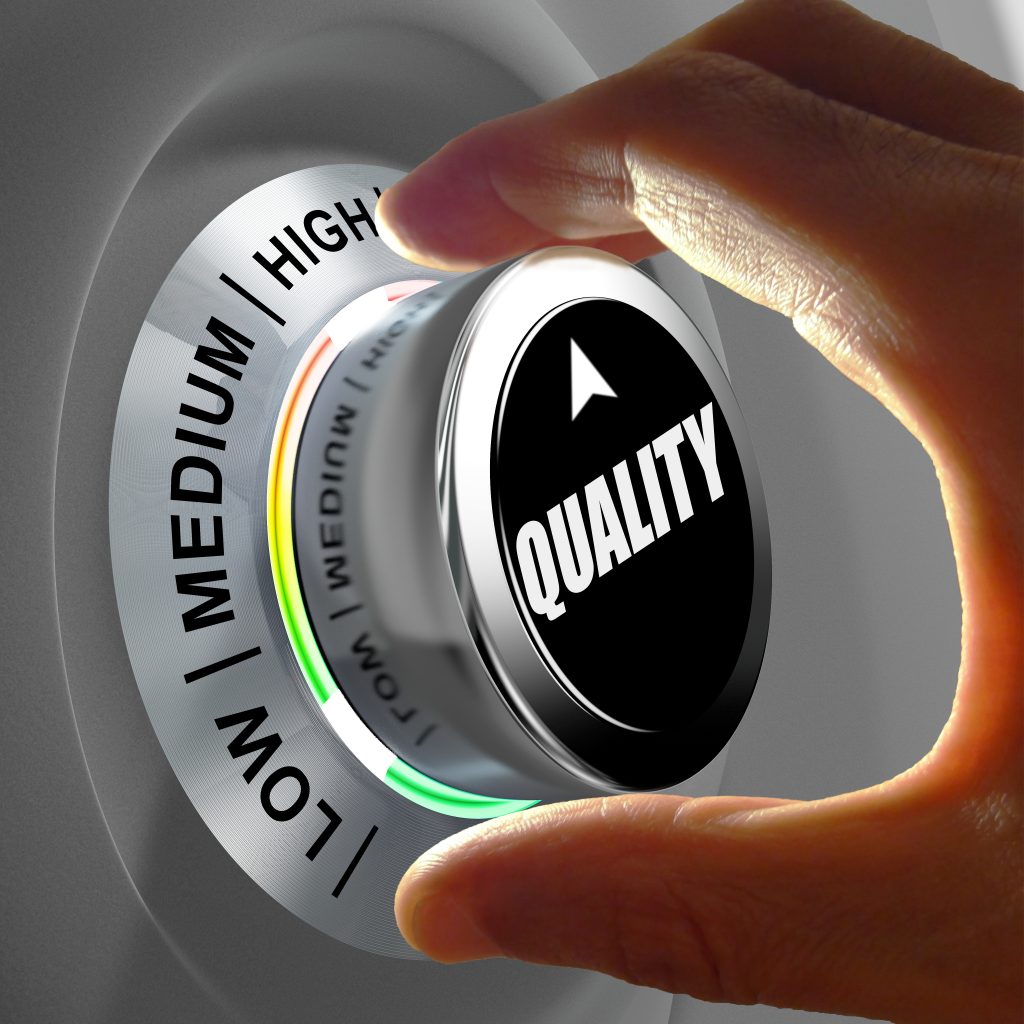“Patent professionals should seek a standardized patent quality assessment methodology that can be applied across all fields of technology and across all organizations globally.”
 With exponential growth in patent filings each year and expanding company portfolios, Patent Quality Assessment (PQA) has become a significant and crucial task. USPTO maintenance fees, which are required to be paid periodically to keep a patent alive for 20 years, further add to the importance of maintaining only quality patents.
With exponential growth in patent filings each year and expanding company portfolios, Patent Quality Assessment (PQA) has become a significant and crucial task. USPTO maintenance fees, which are required to be paid periodically to keep a patent alive for 20 years, further add to the importance of maintaining only quality patents.
Defining Quality
Patent professionals worldwide have developed a myriad of metrics to assess the quality of patent assets. Benchmarking tools include terms like “Qscore” and “Asset indexes” to quantify the qualitative attributes of a patent. The patents are ranked based on various statistical parameters such as:
- Family information
- Citation velocity
- Time to grant
- Number of independent claims
- Examiner response and many more.
Judging the quality of an asset is a subjective analysis. The dictionary meaning of “quality” is “the standard of something as measured against other things of a similar kind” OR “a distinctive characteristic possessed by someone or something”. Hence, we still lack a globally acceptable standard protocol for patent quality assessment.
One yardstick used to gauge the quality of an IP portfolio/ asset is the commercialization phase. If a patent has a product in the market, its quality is undeniably high. The World Intellectual Property Organization (WIPO) has stated, “The returns in terms of profit upon its commercialization are the ultimate proof of the success of any invention or new product.”
However, a Forbes article raises pertinent questions about the commercialization yardstick for PQA. The article indicates that only 5% of the patents filed worldwide are successfully commercialized or licensed. This raises questions about the remaining 95% of patents, such as:
- Were the patent claims not commercially viable?
- Did the patents lack market adaptability?
- Were the inventions not feasible?
- Were the patents solving pseudo problems?
This low rate of success for commercialization suggests there is a need for companies to better assess and categorize patents early on in order to maximize value.
IPQ + HPQ = PQA
Analysis of the following factors can divide the PQA into two categories, as described below:
- Indicative Patent Quality (IPQ): The indicative quality is based on statistical parameters, which indicates a patent to have a commercial scope as well as assertive characteristics. The calculation for IPQ implies various algorithms and regression models focused on the patent meta-data to work out an indicative quality score. To provide a more affirmative score, big data analytics learning from previous patent data is used.
- Hallmark Patent Quality (HPQ): The Hallmark quality is based on market relevance of the IP asset as well as the commercial products sold in the market. The HPQ takes into account the contribution of a patented technology in the overall product specification. A patent being declared as a standard essential patent (SEP) or under litigation can also fall under HPQ.
For an accurate estimation of the PQA of a patent, both IPQ and HPQ should be ascertained, as shown in Figure 1 below.
- Patents with a Positive HPQ score and Positive IPQ score are labelled as Gold.
- Patents with a Positive IPQ and Negative HPQ score are labelled Silver due to their potential of commercialization.
- Patents with a negative HPQ score and negative IPQ score are labelled Bronze.
- Patents with a Positive HPQ score and Negative IPQ score are also labelled as Gold since having Positive HPQ ascertains the market importance of the patents and having negative IPQ score does not affect their value.
FIG.1
Patents falling in the Gold section are considered the most important IP asset for an organization, as they have a direct financial impact on the company’s business streams.
Patents falling in the Silver section are vital as they can lead to future growth of an organization in a particular technology space. These patents can also relate to the future roadmap of the company and could be used for fencing off competitors from the company’s core technology areas. Patents that have a positive IPQ can also be used for licensing opportunities by an organization.
Patents falling in the bronze section are the tertiary IP assets of an organization. These patents can undergo an audit for trimming of the portfolio.
To summarize:
- PQA is a complex task and the above-suggested methodology is one option for achieving a better assessment of the portfolio strength of an organization’s IP assets.
- Patent professionals should seek a standardized quality assessment methodology that can be applied across all fields of technology and across all organizations globally.
- An automated system that links patents to products can be very helpful to IP professionals in estimating HPQ.
- Commercialization of technology holds the key to the success of an invention, as well the company holding the IP.
- The estimation of IPQ and HPQ can provide one standardized protocol for PQA.
Image Source: Deposit Photos
Image ID: 74569981
Copyright: dtjs

![[IPWatchdog Logo]](https://ipwatchdog.com/wp-content/themes/IPWatchdog%20-%202023/assets/images/temp/logo-small@2x.png)


![[Advertisement]](https://ipwatchdog.com/wp-content/uploads/2024/04/Artificial-Intelligence-2024-REPLAY-sidebar-700x500-corrected.jpg)
![[Advertisement]](https://ipwatchdog.com/wp-content/uploads/2024/04/UnitedLex-May-2-2024-sidebar-700x500-1.jpg)
![[Advertisement]](https://ipwatchdog.com/wp-content/uploads/2024/04/Patent-Litigation-Masters-2024-sidebar-700x500-1.jpg)

![[Advertisement]](https://ipwatchdog.com/wp-content/uploads/2021/12/WEBINAR-336-x-280-px.png)
![[Advertisement]](https://ipwatchdog.com/wp-content/uploads/2021/12/2021-Patent-Practice-on-Demand-recorded-Feb-2021-336-x-280.jpg)
![[Advertisement]](https://ipwatchdog.com/wp-content/uploads/2021/12/Ad-4-The-Invent-Patent-System™.png)






Join the Discussion
8 comments so far.
Pinky
August 27, 2019 11:09 amOn the topic of commercialization, isn’t the price and quantity sold of the commercialized product a relevant consideration? A valid, enforceable patent on a tool that sells for $30 and is used by 100 people in the country is not worth the government filing fee, but may score high on your analyses.
A patent on a $2 widget that 10 million people buy in the first year is another matter entirely.
Cost of goods sold is also a factor that I do not see taken into consideration.
Also, in the patent damages world, one has to look at apportionment of the value of the patented feature to the entire selling price, and I do not see that being measured (even too complicated for my little tool vs widget examples).
Bottom line, this whole discussion of “patent quality” is just a bunch of navel-gazing by wannabes.
rudyd
August 26, 2019 01:21 pmAcademia uses the h-index which is based on citations made to an author’s publications to approximate “impact”. Not a perfect measure, but it is helpful. While I certainly agree that commercialization (even if it isn’t ultimately successful) is an important part of patent quality, it would seem that patents that may never be commercialized but that are a catalyst for future innovation need to be accounted for somehow. Problematic because while inventors are required to disclose known prior art via the IDS, they are not required to cite these in the patent itself. How can we capture patent “impact” within assessment of patent quality? Or do we not think that’s important?
Anon1
August 26, 2019 11:17 amI’m sure we all appreciate the effort, but when a non-patent attorney tries to comment on this topic it’s a bit like our commenting on brain surgery (the volume of what this author is unaware of (aka “blind spots”) is staggering).
chetan sharma
August 26, 2019 04:09 amHi @weibin.shi, there is a software module called Patdigger by xlpat.com which is built with the purpose to link patents to web information. You can contact me at [email protected] for more details.
weibin.shi
August 26, 2019 01:56 amhi, Chetan, In your summarize, one is “An automated system that links patents to products can be very helpful to IP professionals in estimating HPQ”, can you give an example of the automated system as you pointed, I hope to know more detail.
PTO-Indentured
August 25, 2019 11:50 amI appreciate the effort being made here to bring some added / much-needed tangible metrics into the ‘patent-value’ picture, and feel this is as good a start as any I have seen represented publicly.
Harder to know factors / metrics, will include…
Competency of decision makers stewarding the fate of a given patent; resources available to the patent holder or licensee, and stick-to-it-iveness in goals and effectively marketing and monetizing of a patent. Marketing quality is not (thus far) being addressed. It is not rare to find individual inventors (or startup) who have a great capacity for coming up with one or more great inventions — thinking (erroneously) that if I ‘build a better mouse trap, the world will beat a path to my door’ wherein the reality is, if you have a better mouse trap you’ll — much more likely — need to do just about everything you can think of in beating a path to at least one door of a competently run company that wants and gets the invention into production–hopefully not blowing the execution of the invention (yes, this happens) — and effectively markets the invention on an ongoing basis. Hint: not having just a tenacious factor, probably more an elevenacious or twelveacious one.
The above factors are somewhat more akin to trying invest in a value attributed to stocks when you don’t really know the quality of the decision makers / stewards of the company and the extent to which resources will be prioritized to effectively back a particular new technology, asset or product.
Metrics will also need to take into account: that inventors often have to be wary of companies that will be completely happy to shelve the invention so that they can maintain a status quo lead position in their market — not requiring change — which keeps competitors (and startups) further at bay by removing new inventions from the hands of their competitors. This not uncommon ploy surely distorts patent-value tracking and reporting. Data analytics can take into a licensing of such inventions relating to a valuable field, although not the higher-import / specific of its (intentionally unavailable) commercialization potential.
Keep up the good work in a pursuit of measurable and objective fact finding and reporting — to the extent that these indexes and scorings improve and are made more available to inventors at all levels — we all will benefit. I appreciate the effort made thus far, reported openly and publicly.
Anon
August 24, 2019 07:06 pmThere is a fundamental — and unsubstantiated — assumption in that the only patent that has value is the patent that is “used.”
Not only is this outright false, it leads to a pernicious trap that “must use” should somehow BE an aspect of patent law.
I am rather surprised that such things involved with NOT using (such as maintaining a differential aspect between items that are made and what any competitors may stake out as their own.
angry dude
August 24, 2019 04:33 pmIs illegal patent commercialization (aka willful or “efficient” patent infringement) by SV companies a measure of patent quality and how can you measure it ?
(Hint: you can’t)
(in view of the fact that small US patent holders do not currently enforce their valid and infringed US patents in the current anti-patent climate)